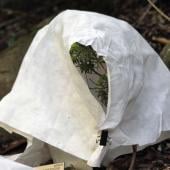How to protect garden plants from frost?
-
AuthorPosts
-
June 17, 2021 at 12:19 pm Reply
Hi plant lovers,
I am also learning how to plant trees because I also love plants. But lately the plants I’ve planted are often dying from frost. I have tried many remedies but still no improvement. So I would like to ask if anyone can give me some advice on how to improve this situation.
Thank you.
June 18, 2021 at 8:51 pm ReplyWell, to really die from a frost, it must be a plant that is not well suited to being outdoors where you live. Maybe it should be kept in pots, moved outside when overnight temperatures are always warm (say, 50°F/10°C? it varies based on the plant) and temporarily bring it back inside when temperatures fall below 50°F/10°C.
Avoid fertilizing plants before your average date of last frost or three months before your average date of first frost. Amending the soil can be done at any time (say, to acidify the soil for example).
Mild winters that have long periods of warm temperatures can make plants break dormancy. Plants can also break dormancy if temperatures gyrate too much from highs to lows.
Very few non-tropical plants will not show problems after a late frost. Once the sap starts flowing and a freeze, frost or a spotty frost hits, the water inside the plant will form ice crystals that will cause injuries. Depending on the weather afterwards and the amount of injury, a plant may quickly or incredibly slowly develop new foliage, new growth from the base, both or neither(when it is dead).
To help a plant, you can bring it inside a protected area if that area will be warm enough (a garage or inside the house) while the bad weather persists only. You can also winter protect the plant (put chicken wire around the plant and fill it with either hay, dead leaves or organic mulch), maintain 2-4″ of organic mulch past the drip line and water deeply before the freeze/frost. As the plant gets taller or bigger, some of these options may no longer be practical.
When potting a plant that can eventually get big (say, consider a plumeria/frangipani that starts small and can get tall), keep the pot on top of rollers always so you can easily/quickly move the pot as the pot gets larger and heavier.
After an even like a frost or freeze, it is best to maintain the soil as evenly moist as you can until you see signs of new growth. I have seen plants do that in 2 weeks and as late as 2.5 months. Once there is a sign of new growth, I provide some fertilizer.
June 21, 2021 at 11:57 pm ReplySome plants we protect with bubble wrap, it doesn’t look very nice but kids say it makes the garden full of lollipops… Other plants like our calla lily we let die on the surface, and in Spring it comes back to life again. It depends what you’re trying to grow, I guess. What is it you’re growing?
In gardening, there’s always something you can’t control. This makes the experience so humbling. 🙂
June 24, 2021 at 1:25 pm Replywill share you few tips on it.
July 16, 2021 at 9:41 am ReplyThe most efficient way to protect plants from frost is to cover them. Covering plants to generate a small pocket of warmer air is the simplest approach to protect them. It’s a good idea to cover fragile plants with bed sheets, drop cloths, blankets, and plastic sheets.
Another way to protect plants is to store your plants in covered places such as a porch or patio until the weather passes. The warmth of your home will help keep your plants insulated.If possible, give less water to plants or water thoroughly several days before an expected frost, freeze, snow, or ice. Otherwise, wait until temperatures reach above freezing before watering your plants. If you must water, do it as the day warms up so that the plants have time to dry off.
Another way to protect plants from frost is to put them in greenhouses. Many small greenhouses offer plenty of protection from winter weather.
September 26, 2021 at 11:40 am ReplyI have some methods for reference:
Irrigation method: Irrigation can increase the air humidity near the ground, protect the ground heat, and increase the air temperature (the air can be heated by about 2°C)
Covering method: Use rice straw, wheat straw, plant ash, weeds, nylon, etc. to cover plants, which can prevent the attack of cold air outside and reduce the heat loss from the ground.
Fumigation method: Use firewood, cow dung, sawn wood, waste engine oil, red phosphorus or other dust and smoke substances that can produce a large amount of smoke, and ignite it half an hour or one hour before the frost.Hope I can help you.
September 28, 2021 at 8:51 am ReplyAh the fumigation method is interesting – but waste engine oil? Perhaps not the best option for a healthy garden…
The other ideas are very interesting though. Has anybody seen “A walk in the clouds”? That’s the movie where the owners wanted to protect against frost by lighting fires between the rows.
Nature & Garden moderator.
Message me if you have any questions, I’ll be glad to help out!
“Winter reveals the strength inside… of those who dare go out!”
January 25, 2022 at 6:55 am Reply- Bring Potted Plants Inside.
- Water Plants in the Afternoon.
- Add a Thick Layer of Mulch.
- Wrap your trees
May 28, 2022 at 1:41 am ReplyCovering plants is the most effective approach to protect them from frost. The simplest way to protect plants is to cover them in order to create a small pocket of warmer air. It’s a good idea to cover fragile plants with bedsheets, drop cloths, blankets, and plastic sheets.
July 6, 2022 at 10:32 am ReplyProtecting plants in the winter requires more effort than in any other season of the year.
You can move your plants indoors to grow them, or you can set up a greenhouse outside. you can set up a heating unit in your greenhouse. Many gardeners prefer a greenhouse, and this is a good option.July 21, 2022 at 11:24 am ReplyIt’s a challenging task for gardeners to protect plants from freezing…
Use Frost Covers.
Place Potted Plants Inside.
Store your plants in covered places.
Do Less watering your plants.
Cover them with Fleece. -
AuthorPosts
- You must log in to post and answer topics. Sign up / Sign in



